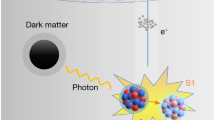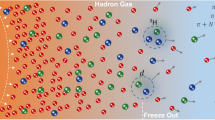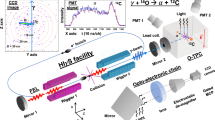Abstract
Light elements were produced in the first few minutes of the Universe through a sequence of nuclear reactions known as Big Bang nucleosynthesis (BBN)1,2. Among the light elements produced during BBN1,2, deuterium is an excellent indicator of cosmological parameters because its abundance is highly sensitive to the primordial baryon density and also depends on the number of neutrino species permeating the early Universe. Although astronomical observations of primordial deuterium abundance have reached percent accuracy3, theoretical predictions4,5,6 based on BBN are hampered by large uncertainties on the cross-section of the deuterium burning D(p,γ)3He reaction. Here we show that our improved cross-sections of this reaction lead to BBN estimates of the baryon density at the 1.6 percent level, in excellent agreement with a recent analysis of the cosmic microwave background7. Improved cross-section data were obtained by exploiting the negligible cosmic-ray background deep underground at the Laboratory for Underground Nuclear Astrophysics (LUNA) of the Laboratori Nazionali del Gran Sasso (Italy)8,9. We bombarded a high-purity deuterium gas target10 with an intense proton beam from the LUNA 400-kilovolt accelerator11 and detected the γ-rays from the nuclear reaction under study with a high-purity germanium detector. Our experimental results settle the most uncertain nuclear physics input to BBN calculations and substantially improve the reliability of using primordial abundances to probe the physics of the early Universe.
This is a preview of subscription content, access via your institution
Access options
Access Nature and 54 other Nature Portfolio journals
Get Nature+, our best-value online-access subscription
$29.99 / 30 days
cancel any time
Subscribe to this journal
Receive 51 print issues and online access
$199.00 per year
only $3.90 per issue
Buy this article
- Purchase on Springer Link
- Instant access to full article PDF
Prices may be subject to local taxes which are calculated during checkout



Similar content being viewed by others
Data availability
Experimental data taken at LUNA are proprietary to the collaboration but can be made available from the corresponding authors upon reasonable request. Values of the thermonuclear reaction rate for smaller temperature steps can be obtained upon request to O.P. (e-mail: pisanti@na.infn.it). Source data are provided with this paper.
Code availability
The PArthENoPE code used for BBN calculations can be made available upon request to O.P. (e-mail: pisanti@na.infn.it).
References
Cyburt, R. H., Fields, B. D., Olive, K. A. & Yeh, T.-H. Big Bang nucleosynthesis: present status. Rev. Mod. Phys. 88, 015004 (2016).
Tanabashi, M. et al. Review of particle physics. Phys. Rev. D 98, 030001 (2018).
Cooke, R., Pettini, M. & Steidel, C. One percent determination of the primordial deuterium abundance. Astrophys. J. 855, 102 (2018).
Pitrou, C., Coc, A., Uzan, J. & Vangioni, E. Precision Big Bang nucleosynthesis with improved helium-4 predictions. Phys. Rep. 754, 1–66 (2018).
Coc, A. et al. New reaction rates for improved primordial D/H calculation and the cosmic evolution of deuterium. Phys. Rev. D 92, 123526 (2015).
Di Valentino, E. et al. Probing nuclear rates with Planck and BICEP2. Phys. Rev. D 90, 023543 (2014).
Aghanim, N. et al. Planck 2018 results. VI. Cosmological parameters. Astron. Astrophys. 641, A6 (2020).
Broggini, C., Bemmerer, D., Caciolli, A. & Trezzi, D. LUNA: status and prospects. Prog. Part. Nucl. Phys. 98, 55–84 (2018).
Cavanna, F. & Prati, P. Direct measurement of nuclear cross-section of astrophysical interest: results and perspectives. Int. J. Mod. Phys. A 33, 1843010–1843042 (2018).
Mossa, V. et al. Setup commissioning for an improved measurement of the D(p,γ)3He cross section at Big Bang nucleosynthesis energies. Eur. Phys. J. A 56, 144 (2020).
Formicola, A. et al. The LUNA II 400kV accelerator. Nucl. Instrum. Methods Phys. Res. A 507, 609–616 (2003).
Fields, B. D., Olive, K. A., Yeh, T.-H. & Young, C. Big-Bang nucleosynthesis after Planck. J. Cosmol. Astropart. Phys. 03, 010 (2020).
Casella, C. et al. First measurement of the d(p,γ)3He cross section down to the solar Gamow peak. Nucl. Phys. A 706, 203–216 (2002).
Ma, L. et al. Measurements of 1H(d→,γ)3He and 2H(p→,γ)3He at very low energies. Phys. Rev. C 55, 588–596 (1997).
Griffiths, G., Larson, E. & Robertson, L. The capture of protons by deuterons. Can. J. Phys. 40, 402–411 (1962).
Schmid, G. et al. The 2H(p,γ)3He and 1H(d,γ)3He reactions below 80 keV. Phys. Rev. C 56, 2565–2581 (1997).
Tišma, I. et al. Experimental cross section and angular distribution of the 2H(p,γ)3He reaction at Big-Bang nucleosynthesis energies. Eur. Phys. J. A 55, 137 (2019).
Marcucci, L., Mangano, G., Kievsky, A. & Viviani, M. Implication of the proton-deuteron radiative capture for Big Bang nucleosynthesis. Phys. Rev. Lett. 116, 102501 (2016).
Adelberger, E. et al. Solar fusion cross sections. II. The pp chain and CNO cycles. Rev. Mod. Phys. 83, 195–245 (2011).
Schmid, G. et al. Effects of non-nucleonic degrees of freedom in the D(\(\overrightarrow{{p}}\),γ)3He and the p(\(\overrightarrow{{d}}\),γ)3He reactions Phys. Rev. Lett. 76, 3088–3091 (1996).
Iliadis, C., Anderson, K. S., Coc, A., Timmes, F. X. & Starrfield, S. Bayesian estimation of thermonuclear reaction rates. Astrophys. J. 831, 107 (2016).
Consiglio, R. et al. PArthENoPE reloaded. Comput. Phys. Commun. 233, 237–242 (2018).
De Salas, P. & Pastor, S. Relic neutrino decoupling with flavour oscillations revisited. J. Cosmol. Astropart. Phys. 07, 051 (2016).
Mangano, G. et al. Relic neutrino decoupling including flavour oscillations. Nucl. Phys. B 729, 221–234 (2005).
Aver, E., Olive, K. A., & Skillman, E. D. The effects of He I λ10830 on helium abundance determinations. J. Cosmol. Astropart. Phys. 07, 011 (2015).
Peimbert, A., Peimbert, M. & Luridiana, V. The primordial helium abundance and the number of neutrino families. Rev. Mex. Astron. Astrofis. 52, 419–424 (2016).
Valerdi, M., Peimbert, A., Peimbert, M. & Sixtos, A. Determination of the primordial helium abundance based on NGC 346, an H ii region of the Small Magellanic Cloud. Astrophys. J. 876, 98 (2019).
Izotov, Y. I., Thuan, T. X. & Guseva, N. G. The primordial deuterium abundance of the most metal-poor damped Lyα system. Mon. Not. R. Astron. Soc. 445, 778–793 (2014).
Griffiths, G., Lal, M. & Scarfe, C. The reaction D(p,γ)3He below 50 keV. Can. J. Phys. 41, 724–736 (1963).
Warren, J. B., Erdman, K. L., Robertson, L. P., Axen, D. A. & Macdonald, J. R. Photodisintegration of 3He near the threshold. Phys. Rev. 132, 1691–1692 (1963).
Geller, K., Muirhead, E. & Cohen, L. The 2H(p,γ)3He reaction at the breakup threshold. Nucl. Phys. A 96, 397–400 (1967).
Ferraro, F. et al. A high-efficiency gas target setup for underground experiments, and redetermination of the branching ratio of the 189.5 keV 22Ne(p,γ)23Na resonance. Eur. Phys. J. A 54, 44 (2018).
Rolfs, C. & Rodney, W. Cauldrons in the Cosmos (Univ. Chicago Press, 1988).
Serpico, P. D. et al. Nuclear reaction network for primordial nucleosynthesis: a detailed analysis of rates, uncertainties and light nuclei yields. J. Cosmol. Astropart. Phys. 2004, 010 (2004).
Nollett, K. M. & Burles, S. Estimating reaction rates and uncertainties for primordial nucleosynthesis. Phys. Rev. D 61, 123505 (2000).
Tumino, A. et al. New determination of the 2H(d,p)3H and 2H(d,n)3He reaction rates at astrophysical energies. Astrophys. J. 785, 96 (2014).
Pisanti, O. et al. PArthENoPE: public algorithm evaluating the nucleosynthesis of primordial elements. Comput. Phys. Commun. 178, 956–971 (2008).
Acknowledgements
We thank D. Ciccotti for accelerator operation and maintenance, for mechanical setups and servicing of the vacuum systems during the course of the experiment; M. D’Incecco for work on custom electronics; M. De Deo for the data acquisition system; G. Sobrero for the new gas target control panel. We also thank the mechanical workshop at LNGS, INFN Bari and Dipartimento Interateneo di Fisica Bari. This work was supported by INFN, with contributions from DFG (BE4100/4-1), Helmholtz Association (ERC-RA-0016), NKFIH (K120666), COST Association (ChETEC CA16117), STFC-UK, University of Naples Compagnia di San Paolo grant STAR, research grant number 2017W4HA7S NAT-NET: ‘Neutrino and Astroparticle Theory Network’ under the programme PRIN 2017 funded by the Italian Ministry of Education, University and Research (MIUR) and INFN Iniziativa Specifica TAsP. R.D. acknowledges funding from the Italian Ministry of Education, University and Research (MIUR) through the ‘Dipartimenti di eccellenza’ project Science of the Universe.
Author information
Authors and Affiliations
Contributions
The experiment at LUNA was proposed by C.G. and coordinated by F.C. and D.T.; P.C., C.G., S.Z. and V.M. planned the setup; S.Z. and P.C. developed the Monte Carlo simulations; S.Z., F.C., P.C., C.G., V.M., K.S. and F.F. led the data analysis. Other authors contributed to the data-taking over a period of two years and to discussion and interpretation of the results obtained. M.J. also had overall responsibility for the accelerator operations and the underground site. G.M. and O.P. performed all BBN calculations and Bayesian analyses. L.E.M., A.K., M.V. performed ab initio calculations. M.A., F.C., C.G., G.M. and O.P. also wrote the paper.
Corresponding authors
Ethics declarations
Competing interests
The authors declare no competing interests.
Additional information
Peer review information Nature thanks Grigory Rogachev and the other, anonymous, reviewer(s) for their contribution to the peer review of this work. Peer reviewer reports are available.
Publisher’s note Springer Nature remains neutral with regard to jurisdictional claims in published maps and institutional affiliations.
Extended data figures and tables
Extended Data Fig. 1 Typical γ-ray spectrum obtained underground with the high-purity germanium detector at proton beam energy Ep = 50 keV.
Typical γ-ray spectrum (blue) obtained with the deuterium gas target at P = 0.3 mbar, clearly showing the full-energy, single-escape and double-escape peaks from the D(p,γ)3He reaction. The continuum is mainly due to Compton scattering events in which photons deposit only part of their energy in the detector. In grey is the beam-induced background spectrum acquired in the control run under the same experimental conditions but with an inert 4He gas target. Both spectra are normalized to the integrated beam current. The region of interest (Eγ ≈ 4.5−5.8 MeV) is essentially background free owing to the million-fold shielding8 from cosmic-ray muons attained at the LUNA underground laboratory.
Extended Data Fig. 2 Typical γ-ray spectrum taken at proton beam energy Ep = 395 keV.
In blue is the γ-ray spectrum obtained with the deuterium gas target at P = 0.3 mbar (the peaks from the D(p,γ)3He reaction are broadened by the Doppler effect at this higher beam energy). In grey is the beam-induced background spectrum (acquired with an inert 4He gas target) due to the 19F contaminant (see text). Its contribution was subtracted leading to net counts on the full-energy peak with a statistical uncertainty of 0.9%. Both spectra are normalized to the integrated beam current.
Extended Data Fig. 3 Sensitivity of the primordial deuterium abundance to the D(p,γ)3He reaction cross-section as a function of centre-of-mass energy.
The greatest sensitivity is obtained around E = 80 keV, where underground measurements are especially effective. The grey area represents the energy region explored at LUNA (see Methods for details).
Supplementary information
Rights and permissions
About this article
Cite this article
Mossa, V., Stöckel, K., Cavanna, F. et al. The baryon density of the Universe from an improved rate of deuterium burning. Nature 587, 210–213 (2020). https://doi.org/10.1038/s41586-020-2878-4
Received:
Accepted:
Published:
Issue Date:
DOI: https://doi.org/10.1038/s41586-020-2878-4
This article is cited by
-
Origin of the elements
The Astronomy and Astrophysics Review (2023)
-
An underground route to grasping the Milky Way’s oldest stars
Nature (2022)
Comments
By submitting a comment you agree to abide by our Terms and Community Guidelines. If you find something abusive or that does not comply with our terms or guidelines please flag it as inappropriate.



